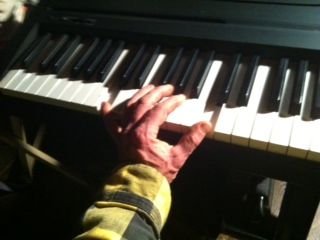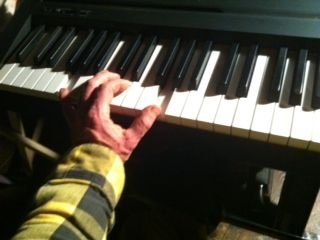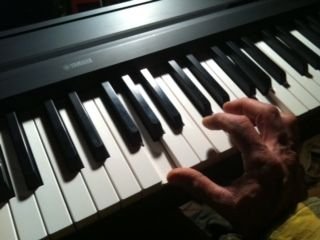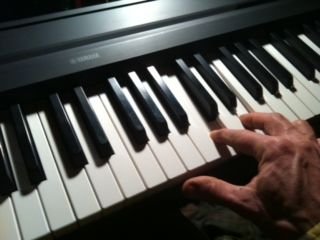If you've ever needed to quickly learn how to play some raggedy saloon music on a piano, for any reason, but such piano-related survival techniques seemed too complicated to learn, I may be able to help by offering the following method; 'Rags with Left-Hand Oompah's'. These syncopated rhythms can sound awfully pretty when things get ugly, and your friends will be amazed at your ability to command dangerous situations with your display of piano prowess after you've learned the methods outlined below.
Basic Survival; The Piano
Let's face it-- there are some rough people in the world, but even the roughest can be soothed with a taste of some saloon piano grooves. It's a well known fact that in all Western movies, when the piano music stops, people die. The piano, then, serves as a wondrous life-saving tool, and can be used to bring order to a wild bunch of hombres. When dangerous people make dangerous rooms, when liquor has flowed and tempers have been lost, this tutorial could save your very life.
There have often been times when the rollicking clang from a piano has been able to effectively change the mood of a volatile crowd, and with the following recipe, using any piano, an otherwise-ugly situation can be turned around instantly with this basic piano technique. By incorporating the skills that I'm about to reveal here, anyone can calm the most unruly crowds with the soothing roar from a single piano, and using these instructions-- as long as you keep playing-- you should be fine.
Here-- using only six photographs-- I will show which keys to press, what a 'chord' looks like, and how to safely rag the chord, and how to train the left hand for it's foundational part in this operation.
Supplies:
Things needed to start:
A piano
A Metronome
Some Time
Metronome
There are Metronome apps available to download onto a phone, while if it's loud enough to be heard over your rollicking piano music, then any metronome should work. This is an important part of the list above, it will inspire and challenge it's user, and a relationship should be formed carefully with the device. That app shouldn't take too long to download.
tic, tic, tic, tic...
Presuming that a piano has been located, tap your foot on the sustain pedal at the speed that you'd like to rollick, and set the metronome to that speed, or tempo.
Right away, some of the training time will be used listening, so that means starting the metronome, and let the beat get to know you. Listen to the metronome, it's entrainment with your ear can save you, when the time comes.
The Left-hand Oompah's
The oompah's are like low tuba sounds, an oomp and a pah, and the following 3 images will show what keys to press to achieve that pulse. Even though it's only 3 little things to do, the left hand is going to need a serious head start on this, so it should be paying attention to these first images:


(Image on left is an 'OOMP'-- image on right is a 'PAH')
The OOMP pictured above consists of two 'C' notes, an interval of one octave.
The PAH pictured above consists of three notes-- every other key; C, E, and G, for a chord.
The THIRD thing that the left hand will do is just another OOMP, another octave:

This OOMP is an octave of G instead of C this time
Oomp Pah
The left hand has it easy, really. That's only three places to be, and every OOMP gets a PAH, so a nice swaggering OOMP PAH, OOMP PAH will look like this:




oomp pah, oomp pah (repeat)
Right Hand, and the Rag
While the left hand is doing that, let's have a look at the photo images of the right hand, and it's critical part in this life-saving piano technique.
The right hand gets to have all of the fun, while the left is busy (make sure it's still oompa-ing down there while we go over this) because the right hand will be able to learn a chord, but then it will thoroughly rag that chord in a syncopated dance over the left hand's thumping oompa's.
The right hand also only has three things to do, and they all can be done with ease, which is why that left hand needed such a head start, it has to learn to stride along with the metronome, and give the right hand something to dance to, and to follow. The right hand hand plays in feelings, and without strict guidelines, so these images (below) will show the movement of one simple rag of a chord, leaving out the infinite variations of the groove for now:


Two notes forming an octave, and then two notes for the little interval on right (above)

An octave of A's-- then back to the little interval of keys (above)
Metronome Again
Let that left hand take a break for a minute-- smoke 'em if you got 'em, while we look at the sustain pedal, as the metronome stays on. (Metronome always stays on!)
Sustain Pedal
On the bottom of the piano there should be a few pedals-- the one on the right should be the sustain pedal.
With the metronome, treat this pedal as if it were a bicycle pedal, and you are climbing to stay on top of the beat that the metronome has set as a pace-- I mean get on that pedal. The whole piano should be rattling now, 'OOMP PAH OOMP PAH OOMP PAH OOMP PAH'... every note gets a push from the pedal. This will give things an old time saloon sound, creating a ring that is there, then gone, pulsating as it goes. It will also help to hide little mistakes.
This short video below will show the left hand doing it's oompah-oompah's, then the right hand will rag it's chord, and then we can hear them together:
Tips and Pointers
Give the left hand a head start. It will most likely try to fight the metronome at first, but the metronome is always right, and it is relentless. It will nag, taunt, and chide the left hand like a drill sergeant, but if the mood of a room needs to be changed in a hurry, the training that a metronome gives can be a life-saver.
Keep stomping that sustain pedal- it's going to make the notes climb together into a rolling carnival of sound, which is often just the thing that is needed.
At some point you might be compelled to change keys or play actual songs, in which case this tutorial may not suffice as a learning tool, since here we are just learning a basic emergency groove which can change things in a hurry, when time matters.
Have Fun
If indoors isn't the safest place to be, just stomp out a tempo on the sustain pedal, as a warning if needed, but with the ring of that wood, the clatter of the hardware inside the clunking peacemaker, it will be hard to resist a quick rollick. By learning the techniques shown above, we can learn to survive those indoor jungles of dangerous characters who just need a song, or something that sounds like one.
----------
thanks for reading
if this was useful, please upvote, comment and share
follow

